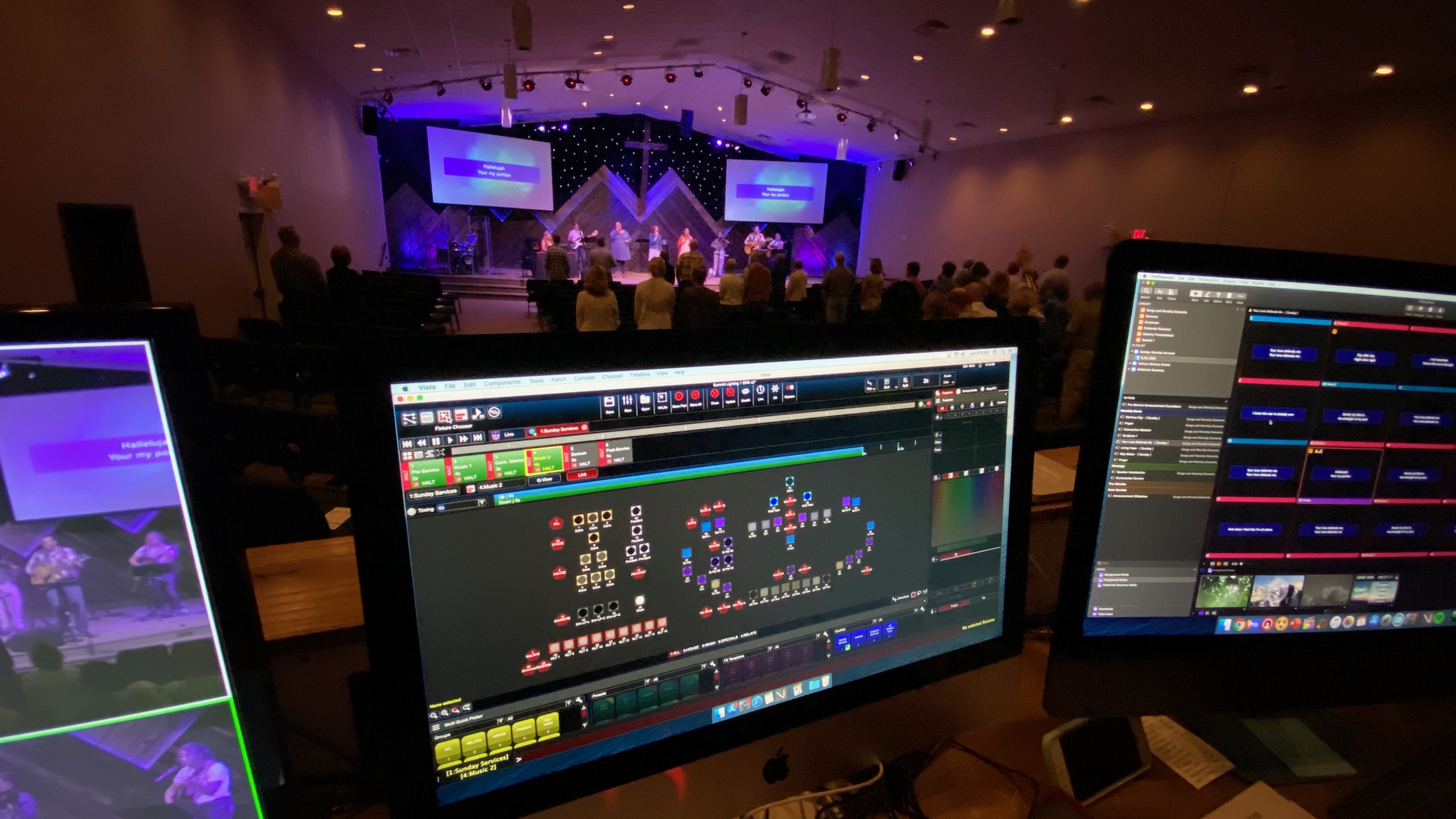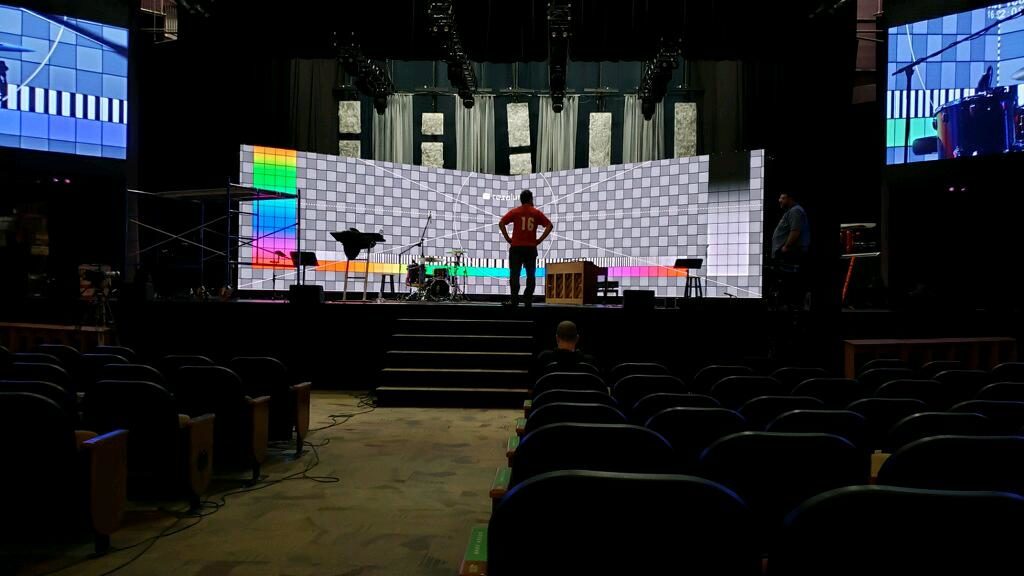
A view of a recent lighting project install at Summit Church in Buffalo, Wyoming. (Photo courtesy of MARCUS HAMMOND)
By Andres Caamano
As churches across the country have had to adjust significantly in these challenging times, work on projects is still readily available.
Unlike many other sectors that in recent months hit the brakes on installation projects, churches have largely continued with installs. Projects planned prior to mid-March, as well as recently planned installations, have kept installers incredibly busy.
“The biggest thing that we have noticed, is if a church as signed a contract, or is in the construction phase by January, they have continued,” noted Marcus Hammond, church resource director for Stark Raving Solutions, based in Lenexa, Kan.
Asked about E2i Design‘s recent workload, CEO Josh Holowicki replied, “We’re working like crazy, which is what we want.”
Overall, Holowicki said things have been moving along to where, “We’ve not seen any reduction in existing projects. New projects have also gone forward with existing and new clients.”
Navigating the supply chain
As a result, installations for E2i Design (based in Brighton, Mich.) have begun “stacking up toward the fall.” The most common hurdle toward a project’s completion now relates to supply chain challenges.
“It’s been an issue whether manufacturers can deliver and provide products in a timely manner,” explained Holowicki. “As a result, it has negatively impacted our installation schedules.”
Unfortunately, the supply issues extend beyond a single manufacturer. “It depends on country of origin, or certain parts,” he added. “When you are doing a big project, oftentimes one little component can hold up a project, because it is a critical piece.”
When a project slows down, oftentimes a limited availability of certain items plays a significant role, noted David Leuschner, executive director of the Digital Great Commission. “The equipment is harder to get your hands on, because some manufacturers have slowed down, or completely stopped.”
Among the most common piece of equipment that is of high demand, are Blackmagic Design’s ATEM Mini Pro HDMI Live Stream Switcher or PTZOptics’ PTZ cameras. “They are great and cost effective. But you can’t get them for like 10 weeks,” noted Hammond. Holowicki concurred about the Blackmagic switcher, adding, “People are knocking down our door for them. That’s the piece that can hold up an install.”
Any slowdowns on a project, though, Leuschner added, can go well beyond just availability of gear.
“Before (COVID-19) you could put your heads together literally (in finding a solution onsite). Now you have to do it by Zoom or by phone, which has “slowed things down. On one project where we are helping a church, the pastor wanted to get things done in two to three weeks,” said Leuschner. “So far, we’ve gone two-and-a-half months, waiting for a vendor to be cleared for work and for a projector.”
Church streaming needs come to forefront

With the challenges this year that churches have faced, some have pushed contracted work into 2021 or 2022, Hammond said. Nonetheless, new projects continue fill much of the void.
Among the most demanded projects of late, Hammond said, are where churches urgently need help getting on board with streaming. The sudden need became glaringly apparent once churches in many states couldn’t hold in-person services for a few months.
The urgency to which some churches approach installers about streaming oftentimes is because a church has yet to start. Leuschner said, “For many of those churches in panic mode, that’s from ignoring an online audience. They didn’t have cameras, and maybe didn’t plan.”
When churches were suddenly unable to host in-person services, Leuschner added, “They might call and say, ‘I need to get on the air, and get on the air now.’ Part of it often is that they might have been small and didn’t think they had the ability. You can start, though, just by using the camera on your phone (as a last resort).”
Over the last few months, the uptick in streaming projects has been significant.
“It’s been streaming (projects) and making the audio experience better (for streaming),” explained Hammond. Going further, not only are new projects incorporating additional streaming, Holowicki said. “Some projects are slightly modifying existing plans to accommodate more streaming.”
In these recent months, the shift away from having most, if not all, the congregation not watching a service in-person, “has caused everybody to relook at their process of video streaming,” noted Holowicki. Prior to March, many churches might have looked at streaming “as a particular tool, a marketing tool, to entice people to come to a live service,” he added. “Now, it’s the primary source of a people’s worship experience, which is completely different.”
How best to ‘spread the Message’
Just a few months ago, Holowicki explained how many churches weren’t effectively spreading their message through streaming, up to where “I have turned off more livestreams than turned on, because it was not a good representation of ministry. It’s not like you do the live service, and do that on video … it’s not going to be successful. Now we are turning more on. Sometimes it takes something dramatic for people to move in that direction.”
The notable shift is recognized by Stefan Svard, president of Audio Video Electronics, based in Brooklyn Park, Minn., who said, “Wholeheartedly, streaming upgrades have seen the most increase. We’ve also seen people looking at LED video walls, that can be part of the backdrop for a streaming system. Or for outdoors, for a church service.”
To Leuschner, the video upgrades have often involved updating cameras and switchers. “Specifically the audio for video. How do we get the audio for video, to be of excellent quality?,” he said. Among the bigger challenges he noted, was with autotuning and mixing worship team. “How do we get the sound to where it sounds like in the room?”
Poor audio for video remains a pervasive issue, Svard noted, with his going as far as to create educational videos to help with mixing for broadcast or a livestream. Making such videos arose upon hearing some “echo-y and terrible (streams), where you couldn’t hear the pastor,” he said. In terms of the livestream experience, he emphasized, “It’s more than just a camera, you have to think about the whole package, and the lighting and audio make it work.”
Churches moving ahead with projects
For some churches, the pauses scheduled in March and April on projects, have already been eased. “There were some projects with signed contracts that were continued. Others that were smaller were paused. Then 45 days ago, the light switch went back on,” explained Svard. “Because of the uncertainty, it is beginning to open up. Some churches have even accelerated their projects before they fully reopen.”
Over the last few months, the work “definitely hasn’t slowed down, it has just changed,” said Leuschner. To account for the significant number of congregation members watching services from home, churches are seeking to complete “more video intense projects. not so much in-the-room intense improvements.”
With a shift toward “video intense projects,” large PA systems in worship spaces have seen a notable decline, added Leuschner. For a new livestream, “when they buy a new PA, that doesn’t translate, so that has been a drop.”
Priority shifts by churches
By comparison, Leuschner has seen increases in recent months in the areas of video, lighting and staging. Each has seen a rise since those watching at home can see the difference during a streamed service. “What people are buying for their rooms, like video cameras, or switchers, those have stepped up to the next level,” he said.
The extent to which churches have sought to improve their video, Hammond explained, goes beyond just the cameras and switchers.
“Video quality is everything. We have done infrastructure projects recently, like with new wiring. With SDI, it works and is reliable,” said Hammond. “With new cameras and switchers, they realize that their congregations are now home. Before they had a few people watching.”
A couple other projects Hammond highlighted included a project in Arizona, where he said, “It’s to do their audio better for their video … to have it sound better for their livestream,” Another project at a cathedral with a video focus will add PTZ cameras. Hidden from the worship space, the cameras are to be “controlled by one person in the back.”
Adjustment of delivery goals
With such examples, they point to how, “The delivery method is just modified. A lot of outreach is still happening, with the presenting of the message. The churches are still going forward as planned, with the goals set forward,” replied Holowicki. “What is changing is their marketing approach and how they are getting in front of people.”
For the churches that have been streaming well before March, and been doing it well, a growing audience has resulted.
“I have heard from churches that have said ‘Our streaming numbers are through the roof,’ and even better than the numbers ever reached for in-person services,” said Svard. “It’s a new frontier for reaching people across the land.”
With so much attention toward streaming, Leuschner said, churches are now thinking how to best “reach a broader audience. Or how do we reach that audience too scared to come into our building? There will be those that will return,” while he acknowledged it won’t be everyone right away.
How will worship change?
As churches have had to adjust the last five months, as much — or all — of their congregation continues to watch worship services from home, worship has seen a change.
“A lot of churches are going shorter (with their services). That’s because they realize it’s too much” simply replicating the standard in-person service online. Churches have looked to see “what connects best with their congregation,” which might be significantly different than spending 45 minutes singing as a congregation. “More worship pastors are asking questions. They ask what does it mean to be in service together, or how do you do worship online,” explained Hammond.
Looking toward the future
Even with churches having made many changes to their services online, Holowicki recognizes an eagerness to return to in-person services.

“People want to get out and get back to their worship communities, and their worship experiences. That’s what church is, to come together,” he said. Nonetheless, Holowicki acknowledged that with these recent changes, they have been “positive. It has made churches recognize it is not about the building you are in. It’s about the people, and about giving the people a great worship experience.”
Svard agreed with Holowicki’s assessment, adding “I think there will be a place for corporate worship, where people come together. I think that people are eager to get together again.” At the same time, though, he sees that streaming will not disappear once in-person services begin to fill up again. “The streaming and web presence is going to be is not going to go away. It will be a tool, an outreach tool.”
Among the unintended benefits from the recent changes, Leuschner outlined, is how pastors “used to ignore the cameras. Now they are speaking to the camera.”
For the many churches using IMAG screens, the pastor now finds themselves speaking not just to those outside the building, but to anyone in the congregation beyond the first four or five rows. That’s because outside of the first few rows, “everyone else is looking at the screens. That’s what they’re trained to do, with the graphics coming up, or the sermon notes. Most pastors don’t realize that, and they disengage with their audience at home. Now when they look at the camera, they look at both audiences.”
Facing these many changes, Svard said integrators and installers are not contending with a “new normal” but instead “new demands.
Andres Caamano is Content Producer for Church Facilities Conference & Expo.


